Which SDM Model, CLIMEX vs. MaxEnt, Best Forecasts Aeolesthes sarta Distribution at a Global Scale under Climate Change Scenarios?
Abstract
Simple Summary
Abstract
1. Introduction
2. Materials and Methods
2.1. Aeolesthes sarta Distribution Datasets
2.2. Climatic Data
2.3. Species Distribution Models (SDMs)
2.4. Creation of Combined Distribution Maps
3. Results
3.1. Model Performance
3.2. Potential Distribution of A. sarta under Current Climatic Conditions Using CLIMEX and MaxEnt
3.3. Potential Distribution of A. sarta under Future Climatic Conditions Using CLIMEX and MaxEnt
3.4. Net Change in Aeolesthes sarta Global Distribution under Future Climate Using CLIMEX and MaxEnt
3.5. Combined Prediction Maps of the Two Models
3.6. Effect of Environmental Factors
4. Discussion and Conclusions
4.1. Assessment of CLIMEX and MaxEnt Models
4.2. Global Projections of A. sarta Distribution under Current and Future Scenarios
4.3. Caveats and Uncertainties
4.4. International Trade Implications for Biosecurity
Supplementary Materials
Author Contributions
Funding
Data Availability Statement
Conflicts of Interest
References
- Byeon, D.H.; Jung, S.; Lee, W.H. Review of CLIMEX and MaxEnt for studying species distribution in South Korea. J. Asia-Pac. Biodivers. 2018, 11, 325–333. [Google Scholar] [CrossRef]
- Lee, H.W. A study of Methodologies Assessing Species Susceptibility to Climate Change; Issue studies of Korea Environment Institute: 2010.
- Kumar, S.; Neven, L.G.; Zhu, H.; Zhang, R. Assessing the global risk of establishment of Cydia pomonella (Lepidoptera: Tortricidae) using CLIMEX and MaxEnt niche models. J. Econ. Entomol. 2015, 108, 1708–1719. [Google Scholar] [CrossRef] [PubMed]
- Hayat, U.; Qin, H.W.; Zhao, J.Q.; Akram, M.; Shi, J.; Ya, Z. Variation in the potential distribution of Agrotis ipsilon (Hufnagel) globally and in Pakistan under current and future climatic conditions. Plant Protect. Sci. 2021, 57, 148–158. [Google Scholar] [CrossRef]
- Kwak, T.S.; Ki, J.H.; Kim, Y.E.; Jeon, H.M.; Kim, S.J. A Study of GIS prediction model of domestic fruit cultivation location changes by the global warming-six tropical and sub-tropical fruits. J. Korea Spat. Inf. Syst. Soc. 2008, 10, 93–106. [Google Scholar]
- Hayat, U.; Kour, S.; Akram, M.; Shi, J.; Wiarta, R. Assessing the Global Pest Risk of Aeolesthes sarta with Regards to the Host Specie Populus alba under Climate Change Scenarios. Forests 2023, 14, 1260. [Google Scholar] [CrossRef]
- Hayat, U.; Akram, M.; Kour, S.; Arif, T.; Shi, J. Pest Risk Assessment of Aeolesthes sarta (Coleoptera: Cerambycidae) in Pakistan under Climate Change Scenario. Forests 2023, 14, 253. [Google Scholar] [CrossRef]
- IPCC. Climate Change 2014: Synthesis Report. Contribution of Working Groups I, II and III to the Fifth Assessment Report of the Intergovernmental Panel on Climate Change; Core Writing Team, Pachauri, R.K., Meyer, L.A., Eds.; IPCC: Geneva, Switzerland, 2014; 151p. [Google Scholar]
- Rosenzweig, C.; Iglesius, A.; Yang, X.B.; Epstein, P.R.; Chivian, E. Climate change and extreme weather events- Implications for food production, plant diseases, and pests. Glob. Change Hum. Health 2001, 2, 90–104. [Google Scholar] [CrossRef]
- Hayat, U. City longhorn beetle (Aeolesthes sarta): A review of the species, its distribution, ecology, damage, prevention and control. J. For. Sci. 2022, 68, 199–212. [Google Scholar] [CrossRef]
- Slipinski, A.; Escalona, H. Australian Longhorn Beetles (Coleoptera: Cerambycidae) Volume 2: Subfamily Cerambycinae; CSIRO Publishing: Clayton, Australia, 2016; Volume 2, p. 640. [Google Scholar]
- Khan, S.A.; Bhatia, S.; Tripathi, N. Entomological investigation on Aeolesthes sarta (Solsky), a major pest on walnut trees (Juglans regia L.) in Kashmir valley. J. Acad. Ind. Res. 2013, 2, 325. [Google Scholar]
- Mazaheri, A.; Khajehali, J.; Marzieh, K.; Hatami, B. Laboratory and field evaluation of insecticides for the control of Aeolesthes sarta Solsky (Col.: Cerambycidae). J. Crop Prot. 2015, 4, 257–266. [Google Scholar]
- Farrashiani, M.E.; Shamohammadi, D.; Sadeghi, S.E. Biological study of Sart longhorn beetle, Aeolesthes sarta Solsky (Coleoptera: Cerambycidae) in the laboratory. J. Entomol. Soc. Iran 2000, 20, 77–90. [Google Scholar]
- Orlinski, A.D. Outcomes of the EPPO project on quarantine pests for forestry 1. Eppo Bull. 2006, 36, 497–511. [Google Scholar] [CrossRef]
- Vanhanen, H.; Veteli, T.O.; Niemelä, P. Potential distribution ranges in Europe for Aeolesthes sarta, Tetropium gracilicorne and Xylotrechus altaicus, a CLIMEX analysis. EPPO Bull. 2008, 38, 239–248. [Google Scholar] [CrossRef]
- CABI. Trirachys Sartus—Invasive Species Compendium. 2022. Available online: https://www.cabi.org/isc/datasheet/3430 (accessed on 26 February 2024).
- Hayat, U.; Abbas, A.; Shi, J. Public Attitudes towards Forest Pest Damage Cost and Future Control Extent: A Case Study from Two Cities of Pakistan. Forests 2024, 15, 544. [Google Scholar] [CrossRef]
- Farashiani, M.E.; Sadeghi, S.E.; Abaii, M. Geographic distribution and hosts of sart longhorn beetle, Aeolesthes sarta Solsky (Col.: Cerambycidae) in Iran. J. Entomol. Soc. Iran 2001, 20, 81–96. [Google Scholar]
- Ahmad, M.I.; Hafiz, I.A.; Chaudhry, M.I. Biological studies on Aeolesthes sarta Solsky attacking poplars in Pakistan. Pak. J. For. 1977, 27, 122–129. [Google Scholar]
- Gul, H.; Chaudhry, M.I. Some observations on natural enemies of poplar borers in Pakistan. Pak. J. For. 1992, 42, 214–222. [Google Scholar]
- Arshad, M.; Hafiz, I.A. Microbial trials of a pathogenic fungus, Beauveria bassiana (Bals.) Vuill. against the adults of Aeolesthes sarta Solsky (Cerambycidae: Coleoptera). Pak. J. Zool. 1983, 15, 213–215. [Google Scholar]
- Bhawane, G.P.; Mamlayya, A.B. Artocarpus hirsutus (Rosales: Moraceae): A new larval food plant of Aeolesthes holosericea (Coleoptera: Cerambycidae). Fla. Entomol. 2013, 96, 274–277. [Google Scholar] [CrossRef]
- Gaffar, S.A.; Bhat, A.A. Management of stem borer, Aeolesthes sarta (Solsky), infesting walnut trees in Kashmir. Indian J. For. 1991, 14, 138–141. [Google Scholar]
- EPPO. Aeolesthes sarta. Datasheets on quarantine pests. EPPO Bull. 2005, 35, 387–389. [Google Scholar] [CrossRef]
- Krivosheina, N.P. Role of the cerambycid Aeolesthes sarta in fruit orchards in Turkmenia. Biologicheskie Nauki 1984, 8, 35–39. [Google Scholar]
- Orlinskiĭ, A.D.; Shakhramanov, I.K.; Mukhanov, S.Y.; Maslyakov, V.Y. Potential quarantine forest pests in the USSR. Zashchita Rasteniĭ 1991, 11, 37–41. [Google Scholar]
- Kulinich, P.N. BZhuki, Vredyashchie Plodovym i Orekho-Plodnym Kul’turam Yuzhnogo Sklona Gissarskogo Khrebta; Dushanbe, Tajikistan. 1965; p. 172. (In Russian) [Google Scholar]
- Kamran, K.; Kakar, A.; Arif, S.; Iqbal, A. Evaluation of insect repellent and insecticide implantation techniques against Aeolesthes sarta Solsky in Quetta district of Baluchistan province, Pakistan. Pak. J. Entomol. Zool. Stud. 2017, 5, 273–276. [Google Scholar]
- Li, X.; Ge, X.; Chen, L.; Zhang, L.; Wang, T.; Zong, S. Climate change impacts on the potential distribution of Eogystia hippophaecolus in China. Pest Manag. Sci. 2019, 75, 215–223. [Google Scholar] [CrossRef]
- Zhao, J.; Ma, L.; Song, C.; Xue, Z.; Zheng, R.; Yan, X.; Hao, C. Modelling potential distribution of Tuta absoluta in China under climate change using CLIMEX and MaxEnt. J. Appl. Entomol. 2023, 147, 895–907. [Google Scholar] [CrossRef]
- Shabani, F.; Kumar, L.; Ahmadi, M. A comparison of absolute performance of different correlative and mechanistic species distribution models in an independent area. Ecol. Evol. 2016, 6, 5973–5986. [Google Scholar] [CrossRef]
- Kriticos, D.J.; Maywald, G.F.; Yonow, T.; Zurcher, E.J.; Herrmann, N.I.; Sutherst, R. Exploring the effects of climate on plants, animals and diseases. CLIMEX Version 2015, 4, 184. [Google Scholar]
- Stoeckli, S.; Felber, R.; Haye, T. Current distribution and voltinism of the brown marmorated stink bug, Halyomorpha halys, in Switzerland and its response to climate change using a high-resolution CLIMEX model. Int. J. Biometeorol. 2020, 64, 2019–2032. [Google Scholar] [CrossRef]
- Zhao, J.; Song, C.; Ma, L.; Yan, X.; Shi, J.; Hao, C. The Impacts of Climate Change on the Potential Distribution of Plodia interpunctella (Hübner) (Lepidoptera: Pyralidae) in China. Insects 2022, 13, 636. [Google Scholar] [CrossRef]
- Srivastava, V.; Lafond, V.; Griess, V.C. Species distribution models (SDM): Applications, benefits and challenges in invasive species management. CABI Rev. 2019, 1–13. [Google Scholar] [CrossRef]
- Kriticos, D.J.; Kean, J.M.; Phillips, C.B.; Senay, S.D.; Acosta, H.; Haye, T. The potential global distribution of the brown marmorated stink bug, Halyomorpha halys, a critical threat to plant biosecurity. J. Pest Sci. 2017, 90, 1033–1043. [Google Scholar] [CrossRef]
- Kriticos, J.M.; Kriticos, D.J. Pretty (and) invasive: The potential global distribution of Tithonia diversifolia under current and future climates. Invasive Plant Sci. Manag. 2021, 14, 205–213. [Google Scholar] [CrossRef]
- Wei, J.; Peng, L.; He, Z.; Lu, Y.; Wang, F. Potential distribution of two invasive pineapple pests under climate change. Pest Manag. Sci. 2020, 76, 1652–1663. [Google Scholar] [CrossRef]
- Zhou, Y.; Ge, X.; Liu, J.; Zou, Y.; Guo, S.; Wang, T.; Zong, S. Climate change effects on the global distribution and range shifts of citrus longhorned beetle Anoplophora chinensis. J. Appl. Entomol. 2022, 146, 473–485. [Google Scholar] [CrossRef]
- Gao, X.; Zhao, Q.; Wei, J.; Zhang, H. Study on the Potential Distribution of Leptinotarsa decemlineata and Its Natural Enemy Picromerus bidens Under Climate Change. Front. Ecol. Evol. 2022, 9, 786436. [Google Scholar] [CrossRef]
- Li, D.; Li, Z.; Liu, Z.; Yang, Y.; Khoso, A.G.; Wang, L.; Liu, D. Climate change simulations revealed potentially drastic shifts in insect community structure and crop yields in China’s farmland. J. Pest Sci. 2023, 96, 55–69. [Google Scholar] [CrossRef]
- Kriticos, D.J.; Webber, B.L.; Leriche, A.; Ota, N.; Macadam, I.; Bathols, J.; Scott, J.K. CliMond: Global high-resolution historical and future scenario climate surfaces for bioclimatic modelling. Methods Ecol. Evol. 2012, 3, 53–64. [Google Scholar] [CrossRef]
- da Silva, R.S.; Kumar, L.; Shabani, F.; Picanço, M.C. Potential risk levels of invasive Neoleucinodes elegantalis (small tomato borer) in areas optimal for open-field Solanum lycopersicum (tomato) cultivation in the present and under predicted climate change. Pest Manag. Sci. 2017, 73, 616–627. [Google Scholar] [CrossRef] [PubMed]
- Stocker, T.F.; Qin, D.; Plattner, G.K.; Tignor, M.M.; Allen, S.K.; Boschung, J.; Nauels, A.; Xia, Y.; Bex, V.; Midgley, P.M. Climate Change 2013: The Physical Science Basis; contribution of working group I to the fifth assessment report of IPCC the intergovernmental panel on climate change; Intergovernmental Panel on Climate Change: Cambridge, UK, 2014. [Google Scholar]
- van Vuuren, D.P.; Carter, T.R. Climate and socio-economic scenarios for climate change research and assessment: Reconciling the new with the old. Clim. Chang. 2014, 122, 415–429. [Google Scholar] [CrossRef]
- Finch, E.A.; Beale, T.; Chellappan, M.; Goergen, G.; Gadratagi, B.G.; Khan, M.A.M.; Rehman, A.; Rwomushana, I.; Sarma, A.K.; Wyckhuys, K.A.; et al. The potential global distribution of the papaya mealybug, Paracoccus marginatus, a polyphagous pest. Pest Manag. Sci. 2021, 77, 1361–1370. [Google Scholar] [CrossRef]
- Aidoo, O.F.; Souza, P.G.C.; da Silva, R.S.; Santana, P.A., Jr.; Picanço, M.C.; Kyerematen, R.; Sètamou, M.; Ekesi, S.; Borgemeister, C. Climate-induced range shifts of invasive species (Diaphorina citri Kuwayama). Pest Manag. Sci. 2022, 78, 2534–2549. [Google Scholar] [CrossRef] [PubMed]
- Lu, Y.; Zhao, Q.; Cheng, L.; Zhao, L.; Zhang, H.; Wei, J. The potential global distribution of the white peach scale pseudaulacaspis pentagona (Targioni tozzetti) under climate change. Forests 2020, 11, 192. [Google Scholar] [CrossRef]
- Cobos, M.E.; Peterson, A.T.; Barve, N.; Osorio-Olvera, L. kuenm: An R package for detailed development of ecological niche models using Maxent. PeerJ 2019, 7, e6281. [Google Scholar] [CrossRef] [PubMed]
- Phillips, S.J.; Anderson, R.P.; Schapire, R.E. Maximum entropy modeling of species geographic distributions. Ecol. Model. 2006, 190, 231–259. [Google Scholar] [CrossRef]
- Jung, J.M.; Lee, W.H.; Jung, S. Insect distribution in response to climate change based on a model: Review of function and use of CLIMEX. Entomol. Res. 2016, 46, 223–235. [Google Scholar] [CrossRef]
- Marmion, M.; Luoto, M.; Heikkinen, R.K.; Thuiller, W. The performance of state-of-the-art modelling techniques depends on geographical distribution of species. Ecol. Model. 2009, 220, 3512–3520. [Google Scholar] [CrossRef]
- Fithian, W.; Hastie, T. Finite-sample equivalence in statistical models for presence-only data. Ann. Appl. Stat. 2013, 7, 1917. [Google Scholar] [CrossRef] [PubMed]
- Merow, C.; Smith, M.J.; Silander, J.A., Jr. A practical guide to MaxEnt for modeling species’ distributions: What it does, and why inputs and settings matter. Ecography 2013, 36, 1058–1069. [Google Scholar] [CrossRef]
- Early, R.; Rwomushana, I.; Chipabika, G.; Day, R. Comparing, evaluating and combining statistical species distribution models and CLIMEX to forecast the distributions of emerging crop pests. Pest Manag. Sci. 2022, 78, 671–683. [Google Scholar] [CrossRef]
- Sutherst, R.W. Pest species distribution modelling: Origins and lessons from history. Biol. Invasions 2014, 16, 239–256. [Google Scholar] [CrossRef]
- Elith, J.; Phillips, S.J.; Hastie, T.; Dudík, M.; Chee, Y.E.; Yates, C.J. A statistical explanation of MaxEnt for ecologists. Divers. Distrib. 2011, 17, 43–57. [Google Scholar] [CrossRef]
- Kumar, S.; Yee, W.L.; Neven, L.G. Mapping global potential risk of establishment of Rhagoletis pomonella (Diptera: Tephritidae) using MaxEnt and CLIMEX niche models. J. Econ. Entomol. 2016, 109, 2043–2053. [Google Scholar] [CrossRef]
- Sutherst, R.W.; Maywald, G.F.; Kriticos, D.J. CLIMEX Version 3: User’s Guide; Hearne Scientific Software Pty Ltd.: Melbourne, Australia, 2007; p. 47. Available online: http://www.hearne.com.au/attachments/ClimexUserGuide3.pdf (accessed on 8 March 2024).
- Dormann, C.F.; Elith, J.; Bacher, S.; Buchmann, C.; Carl, G.; Carré, G.; Marquéz, J.R.G.; Gruber, B.; Lafourcade, B.; Leitão, P.J.; et al. Collinearity: A review of methods to deal with it and a simulation study evaluating their performance. Ecography 2013, 36, 27–46. [Google Scholar] [CrossRef]
- Syfert, M.M.; Smith, M.J.; Coomes, D.A. The effects of sampling bias and model complexity on the predictive performance of MaxEnt species distribution models. PLoS ONE 2013, 8, e55158. [Google Scholar] [CrossRef]
- Taylor, S.; Kumar, L. Sensitivity analysis of CLIMEX parameters in modelling potential distribution of Lantana camara L. PLoS ONE 2012, 7, e40969. [Google Scholar] [CrossRef] [PubMed]
- Shcheglovitova, M.; Anderson, R.P. Estimating optimal complexity for ecological niche models: A jackknife approach for species with small sample sizes. Ecol. Model. 2013, 269, 9–17. [Google Scholar] [CrossRef]
- Boria, R.A.; Olson, L.E.; Goodman, S.M.; Anderson, R.P. Spatial filtering to reduce sampling bias can improve the performance of ecological niche models. Ecol. Model. 2014, 275, 73–77. [Google Scholar] [CrossRef]
- Porter, J.H.; Parry, M.L.; Carter, T.R. The potential effects of climatic change on agricultural insect pests. Agric. For. Meteorol. 1991, 57, 221–240. [Google Scholar] [CrossRef]
- Hijmans, R.J.; Cameron, S.E.; Parra, J.L.; Jones, P.G.; Jarvis, A. Very high resolution interpolated climate surfaces for global land areas. Int. J. Climatol. A J. R. Meteorol. Soc. 2005, 25, 1965–1978. [Google Scholar] [CrossRef]
- Kumar, S.; Neven, L.G.; Yee, W.L. Assessing the potential for establishment of western cherry fruit fly using ecological niche modeling. J. Econ. Entomol. 2014, 107, 1032–1044. [Google Scholar] [CrossRef] [PubMed]
- Saikkonen, K.; Taulavuori, K.; Hyvönen, T.; Gundel, P.E.; Hamilton, C.E.; Vänninen, I.; Nissinen, A.; Helander, M. Climate change-driven species’ range shifts filtered by photoperiodism. Nat. Clim. Chang. 2012, 2, 239–242. [Google Scholar] [CrossRef]
- Bacon, S.J.; Aebi, A.; Calanca, P.; Bacher, S. Quarantine arthropod invasions in Europe: The role of climate, hosts and propagule pressure. Divers. Distrib. 2014, 20, 84–94. [Google Scholar] [CrossRef]
- Sutherst, R.W.; Maywald, G.F.; Bourne, A.S. Including species interactions in risk assessments for global change. Glob. Chang. Biol. 2007, 13, 1843–1859. [Google Scholar] [CrossRef]
- Nevidomov, A.M. Ecophytocoenotic patterns in the distribution of poplar forests in the floodplains of southeastern European Russia. Bot. Zhurnal 1994, 79, 47–58. [Google Scholar]
- Modir-Rahmati, A. Cultivation of poplar in Iran. Holzzucht 1997, 51, 41–43. [Google Scholar]
- Pasiecznik, N.M.; Smith, I.M.; Watson, G.W.; Brunt, A.A.; Ritchie, B.; Charles, L.M.F. CABI/EPPO distribution maps of plant pests and plant diseases and their important role in plant quarantine. Eppo Bull. 2005, 35, 1–7. [Google Scholar] [CrossRef]
- Afshan, N.S.; Iqbal, S.H.; Khalid, A.N.; Niazi, A.R. Some additions to the uredinales of Azad Jammu and Kashmir (AJ & K), Pakistan. Pak. J. Bot. 2011, 43, 1373–1379. [Google Scholar]
- Pasiecznik, N. Populus alba (silver-leaf poplar). In CABI Compendium; CABI International: Wallingford, UK, 2022. [Google Scholar] [CrossRef]
- Sekawin, M. Genetics of Populus alba. Ann. For. 1975, 6, 159–189. [Google Scholar]
- Gucker, C.L. Populus alba and hybrids. In Fire Effects Information System, [Online]; U.S. Department of Agriculture, Forest Service, Rocky Mountain Research Station, Fire Sciences Laboratory (Producer): Missoula, MT, USA, 2010. Available online: https://www.fs.usda.gov/database/feis/plants/tree/popspp/all.html (accessed on 15 May 2023).
- Domingo, I.L.; Gordon, J.C. Physiological responses of an aspen-poplar hybrid to air temperature and soil moisture. Bot. Gaz. 1974, 135, 184–192. [Google Scholar] [CrossRef]
- Rédei, K. Early evaluation of promising white poplar (Populus alba L.) clones in sandy ridges between the rivers Danube and Tisza in Hungary. Silva Lusit. 1998, 6, 63–71. [Google Scholar]

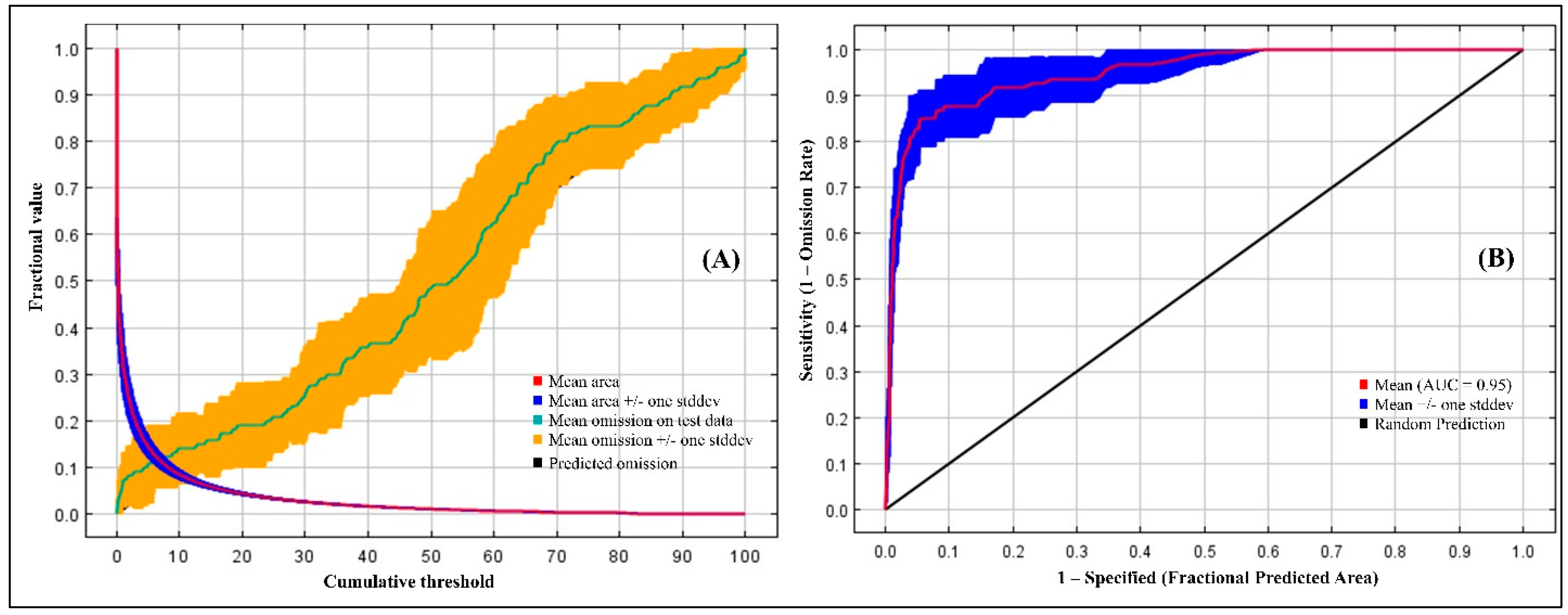
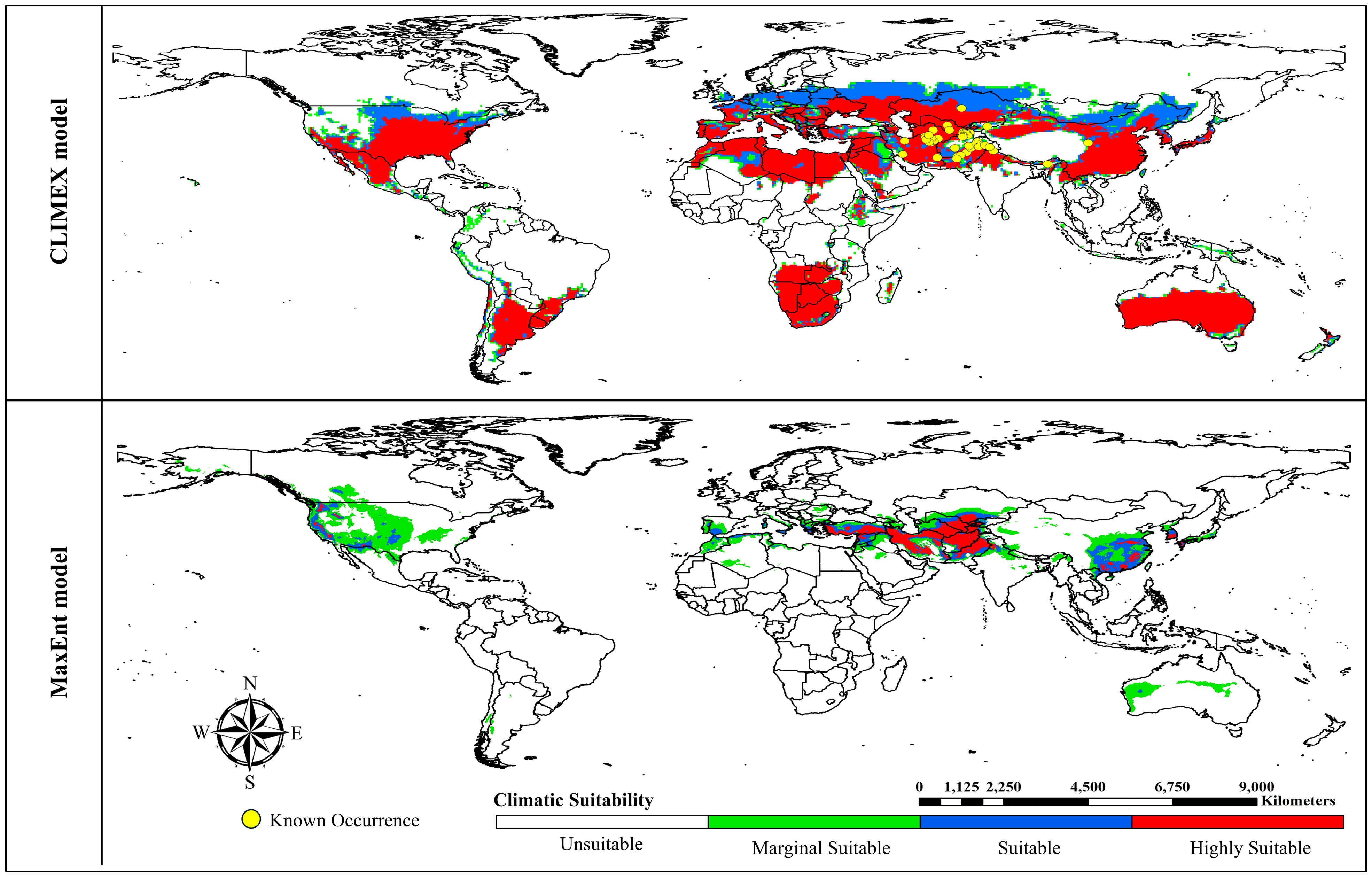
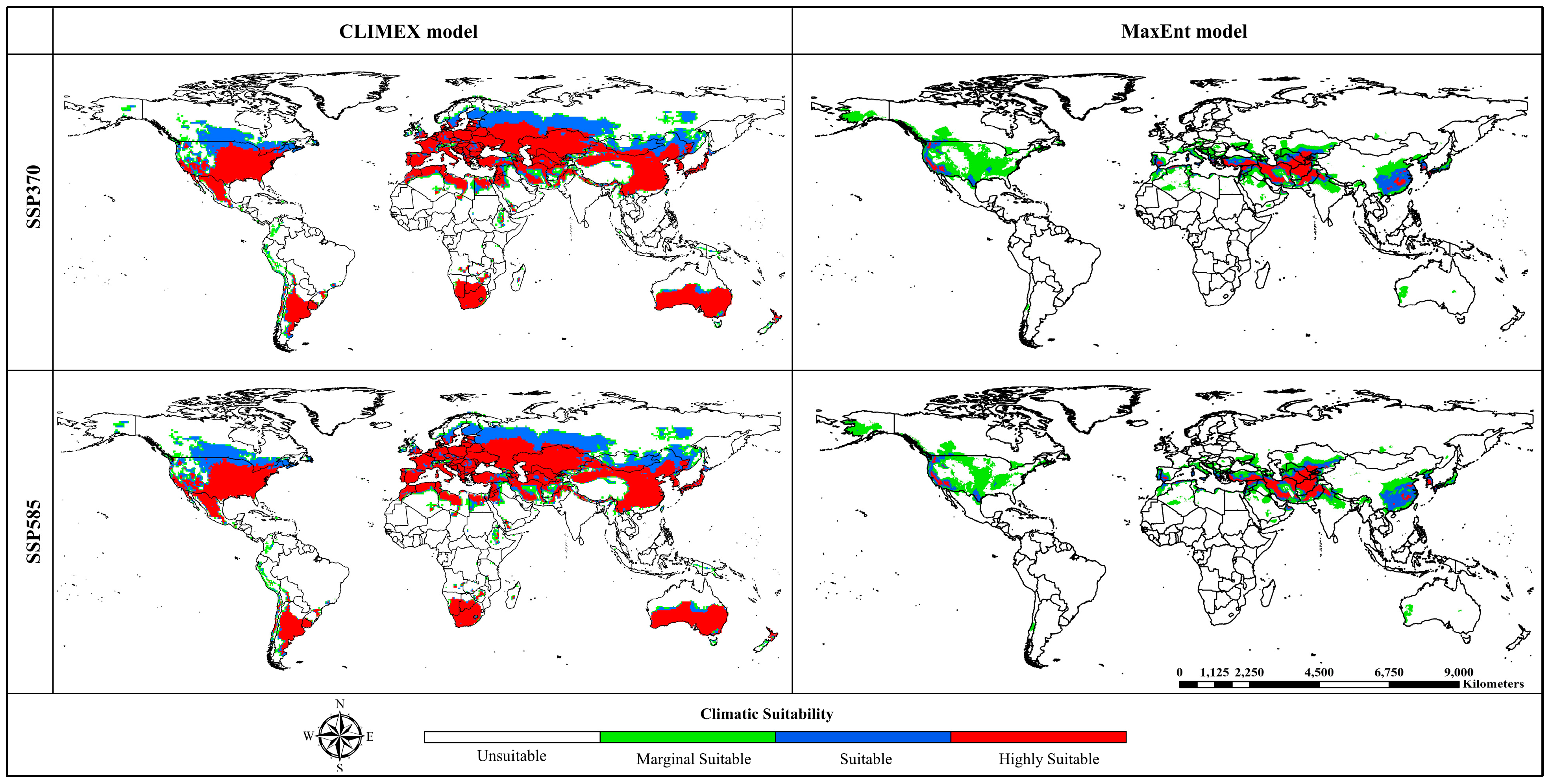
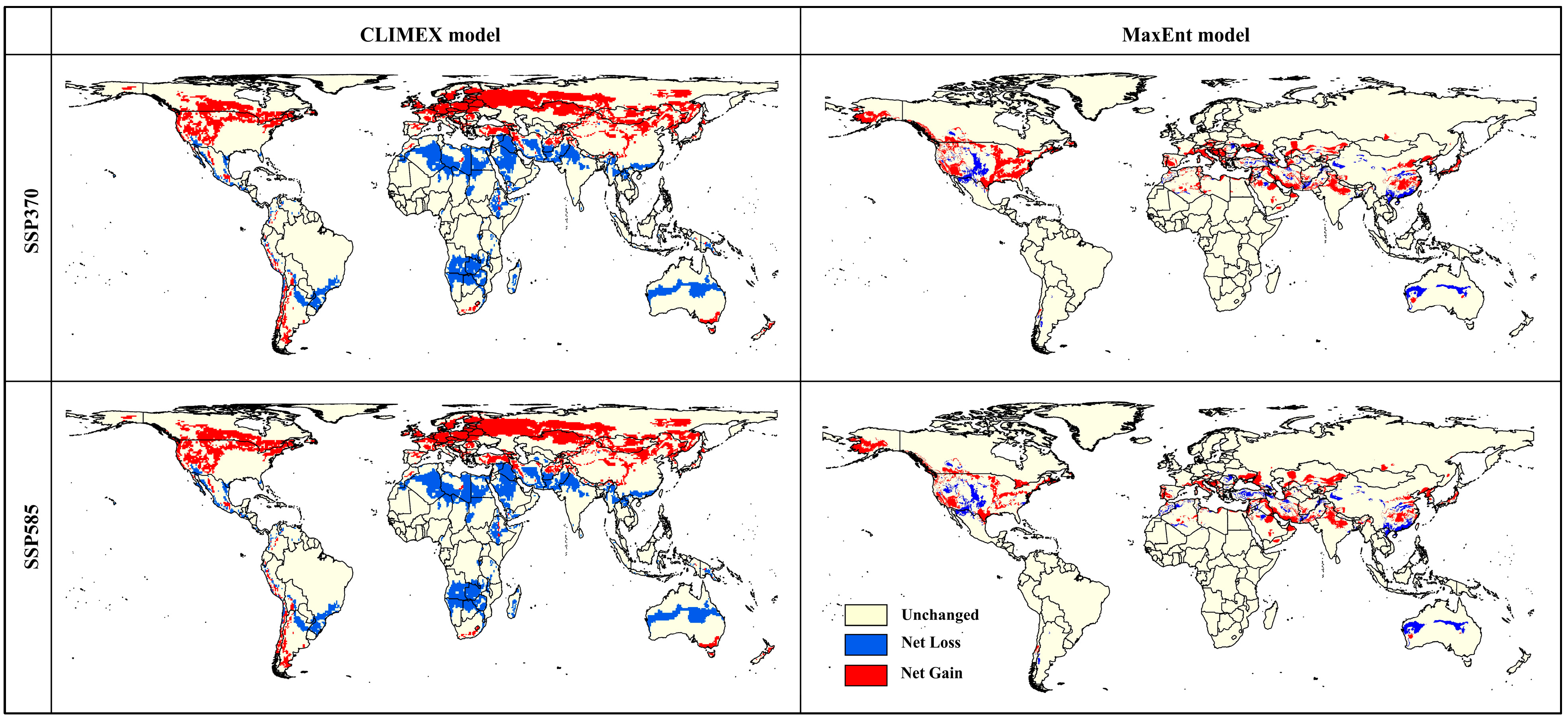

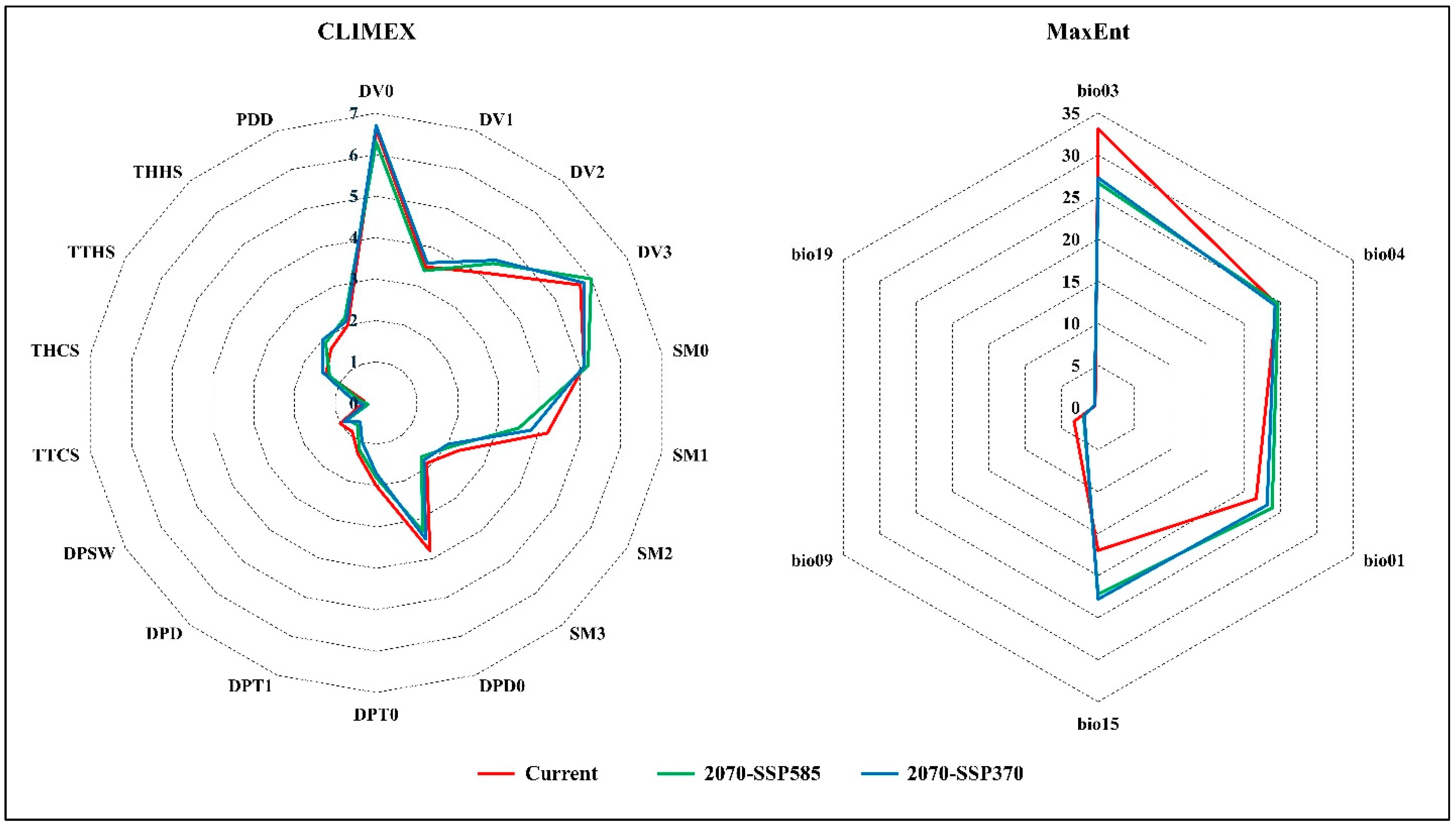
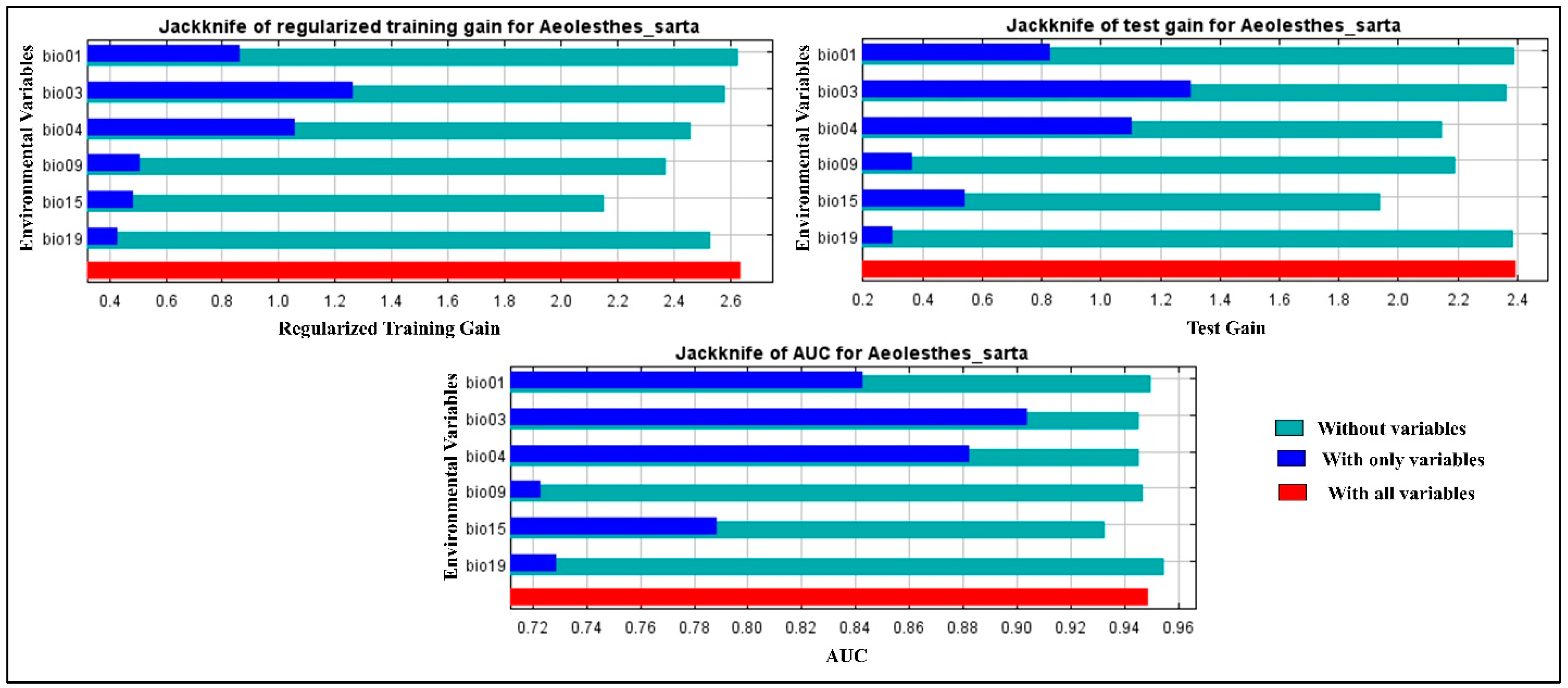
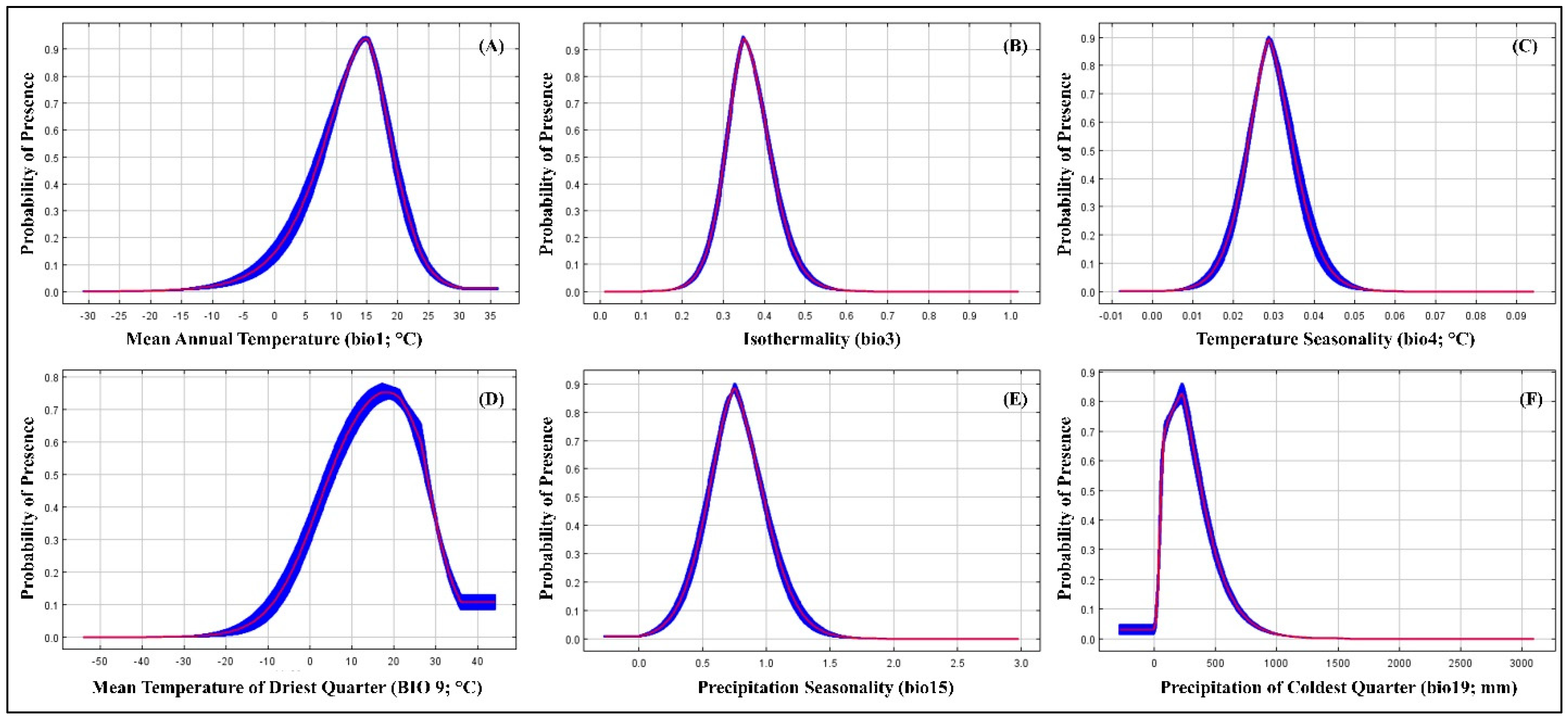
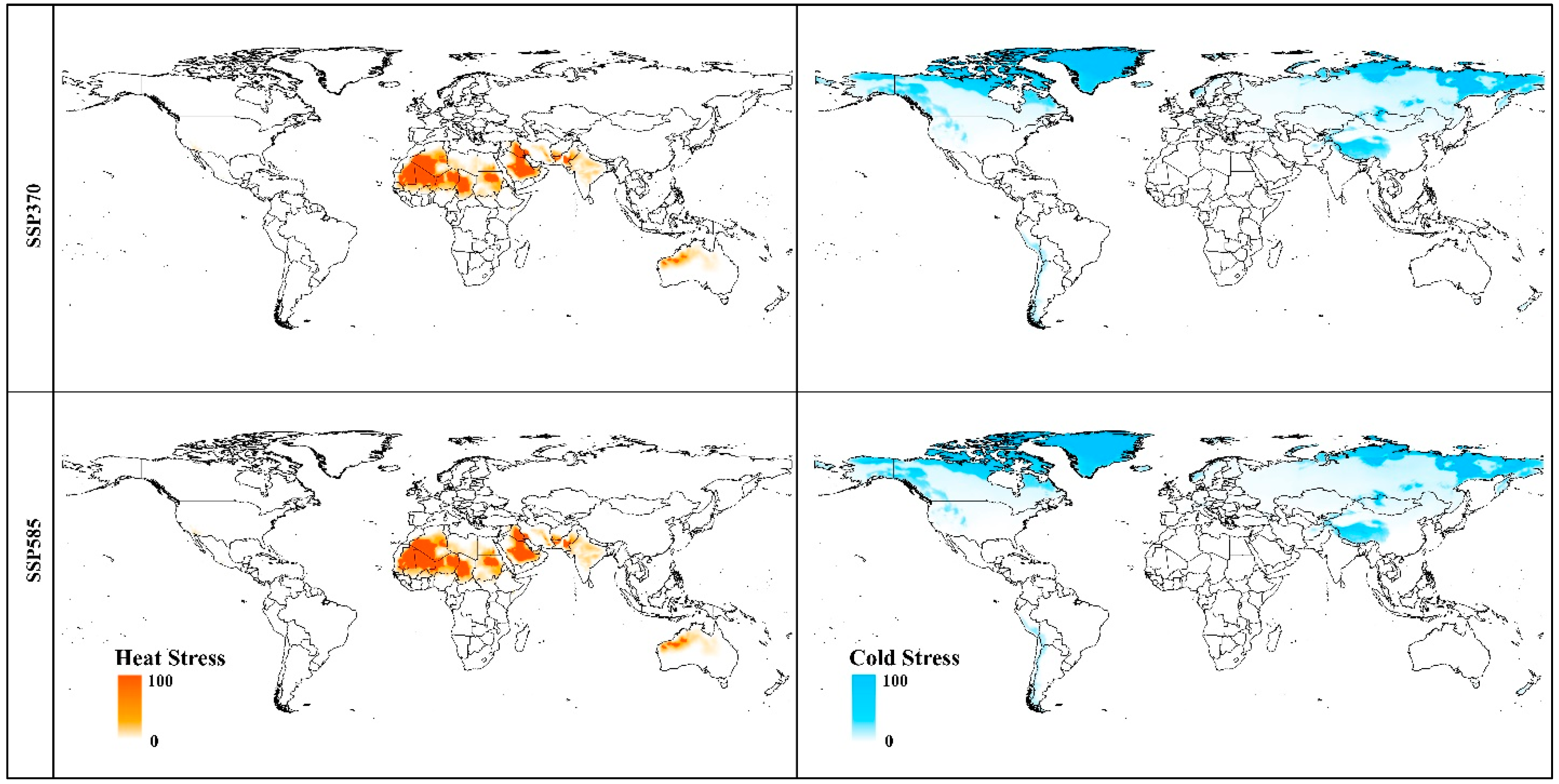
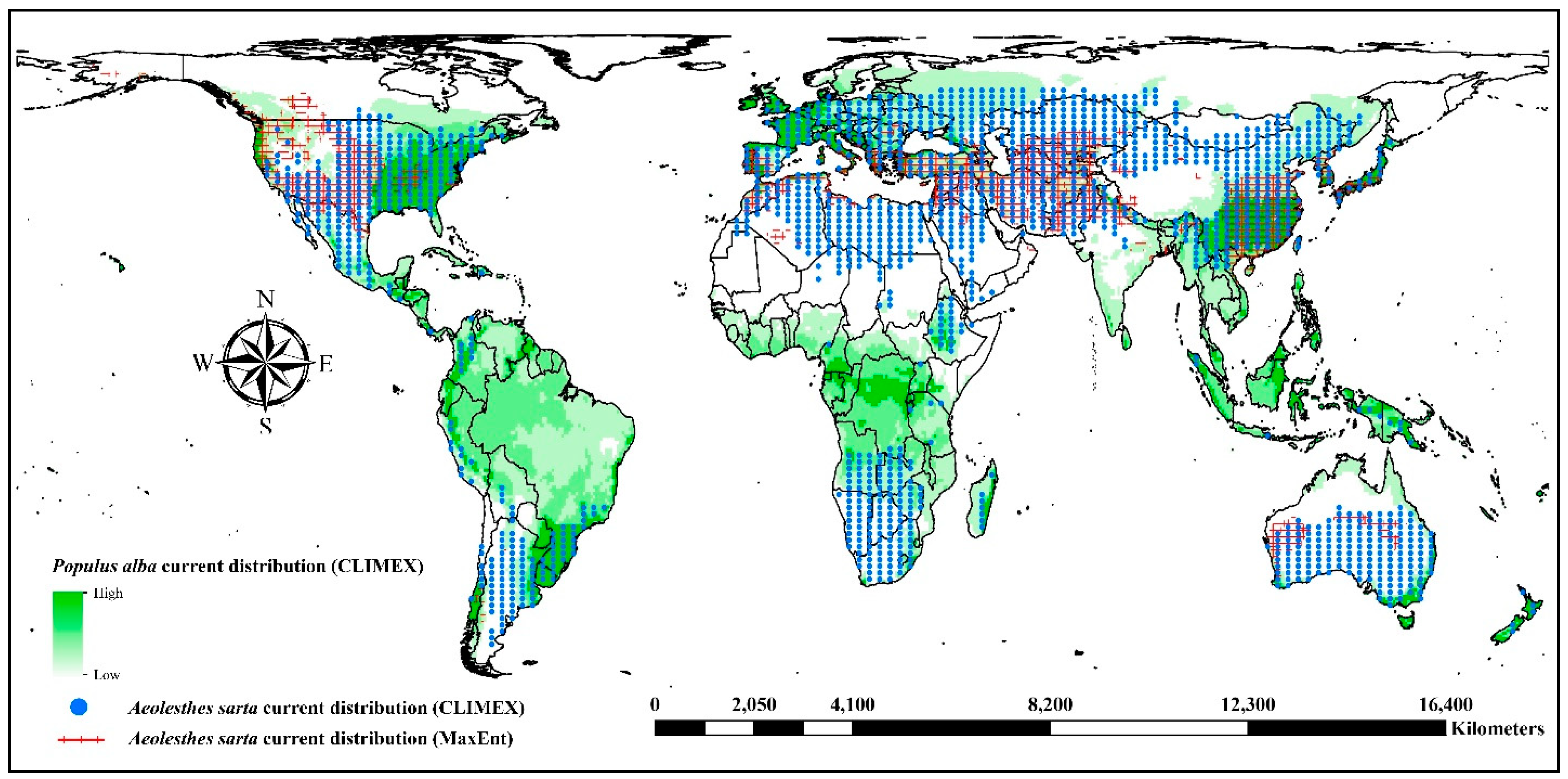
| Parameters | Code | Values | |
|---|---|---|---|
| Aeolesthes sarta | |||
| Temperature | Limiting low temperature (°C) | DV0 | 10 |
| Lower optimal temperature (°C) | DV1 | 15 | |
| Upper optimal temperature (°C) | DV2 | 37 | |
| Limiting high temperature (°C) | DV3 | 40 | |
| Moisture Index | Limiting low soil moisture | SM0 | 0 |
| Lower optimal soil moisture | SM1 | 0.001 | |
| Upper optimal soil moisture | SM2 | 1.5 | |
| Limiting high soil moisture | SM3 | 2.5 | |
| Diapause Index | Diapause induction day length | DPD0 | 12 |
| Diapause induction temperature (°C) | DPT0 | 13 | |
| Diapause termination temperature (°C) | DPT1 | 10 | |
| Diapause development days | DPD | 90 | |
| Summer or winter Diapause | DPSW | 0 | |
| Cold Stress | CS temperature threshold (°C) | TTCS | 9 |
| CS temperature rate | THCS | −0.00001 | |
| Heat Stress | HS temperature threshold (°C) | TTHS | 41 |
| HS temperature rate | THHS | 0.005 | |
| Population degree day | PDD | 700 | |
| Environmental Variable | Interpretation |
|---|---|
| bio1 | Annual mean temperature |
| bio2 | Mean diurnal range (mean of monthly (max temp − min temp)) |
| bio3 | Isothermality (Bio2/Bio7) (*100) |
| bio4 | Temperature Seasonality (standard deviation * 100) |
| bio5 | Max Temperature of Warmest Month |
| bio6 | Min Temperature of Coldest Month |
| bio7 | Temperature Annual Range (Bio5–Bio6) |
| bio8 | Mean Temperature of Wettest Quarter |
| bio9 | Mean Temperature of Driest Quarter |
| bio10 | Mean Temperature of Warmest Quarter |
| bio11 | Mean Temperature of Coldest Quarter |
| bio12 | Annual precipitation Seasonality |
| bio13 | Precipitation of Wettest Month |
| bio14 | Precipitation of driest month |
| bio15 | Precipitation Seasonality (Coefficient of Variation) |
| bio16 | Precipitation of Wettest Quarter |
| bio17 | Precipitation of Driest Quarter |
| bio18 | Precipitation of Warmest Quarter |
| bio19 | Precipitation of Coldest Quarter |
| Rank | FC | RM | Partial ROC | Omission Rate at 5% | AICc | Delta AICc |
|---|---|---|---|---|---|---|
| 1 | QPT | 1.9 | 0 | 0.046 | 9508.12 | 0 |
| Variable | Percentage Contribution | Permutation Importance |
|---|---|---|
| bio03 | 33.1 | 25.4 |
| bio04 | 24.5 | 34.6 |
| bio01 | 21.7 | 15.8 |
| bio15 | 17 | 6.4 |
| bio09 | 3.3 | 16.5 |
| bio19 | 0.4 | 1.3 |
Disclaimer/Publisher’s Note: The statements, opinions and data contained in all publications are solely those of the individual author(s) and contributor(s) and not of MDPI and/or the editor(s). MDPI and/or the editor(s) disclaim responsibility for any injury to people or property resulting from any ideas, methods, instructions or products referred to in the content. |
© 2024 by the authors. Licensee MDPI, Basel, Switzerland. This article is an open access article distributed under the terms and conditions of the Creative Commons Attribution (CC BY) license (https://creativecommons.org/licenses/by/4.0/).
Share and Cite
Hayat, U.; Shi, J.; Wu, Z.; Rizwan, M.; Haider, M.S. Which SDM Model, CLIMEX vs. MaxEnt, Best Forecasts Aeolesthes sarta Distribution at a Global Scale under Climate Change Scenarios? Insects 2024, 15, 324. https://doi.org/10.3390/insects15050324
Hayat U, Shi J, Wu Z, Rizwan M, Haider MS. Which SDM Model, CLIMEX vs. MaxEnt, Best Forecasts Aeolesthes sarta Distribution at a Global Scale under Climate Change Scenarios? Insects. 2024; 15(5):324. https://doi.org/10.3390/insects15050324
Chicago/Turabian StyleHayat, Umer, Juan Shi, Zhuojin Wu, Muhammad Rizwan, and Muhammad Sajjad Haider. 2024. "Which SDM Model, CLIMEX vs. MaxEnt, Best Forecasts Aeolesthes sarta Distribution at a Global Scale under Climate Change Scenarios?" Insects 15, no. 5: 324. https://doi.org/10.3390/insects15050324
APA StyleHayat, U., Shi, J., Wu, Z., Rizwan, M., & Haider, M. S. (2024). Which SDM Model, CLIMEX vs. MaxEnt, Best Forecasts Aeolesthes sarta Distribution at a Global Scale under Climate Change Scenarios? Insects, 15(5), 324. https://doi.org/10.3390/insects15050324






